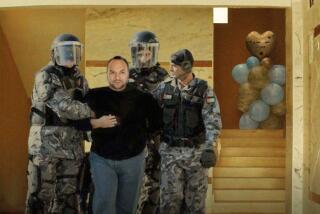Saudi Arabia ‘day of rage’ protest fizzles
- Share via
Reporting from Riyadh, Saudi Arabia — A call for protests in Saudi Arabia that had been talked about for weeks drew only a small number of people Friday, allowing the kingdom to keep at bay the waves of political unrest that have battered the Arab world.
The “day of rage” fizzled in all but restive Eastern province, where the country’s minority Shiite Muslims have been holding demonstrations for weeks. Several hundred protesters turned out in the cities of Hofuf, Awwamiya and Qatif to demand the release of political prisoners, according to news service reports.
But no protests occurred in other major Saudi cities, said Interior Ministry spokesman Maj. Gen. Mansour Turki. “You’ve seen the response of the Saudi people,” Turki said. “This is their response to the call for protest.”
The prospect of street protests in the highly conservative kingdom provoked people’s curiosity, but few Saudis expected a big turnout.
Even though Saudi Arabia has serious problems with youth unemployment, official corruption and discrimination against women and most religious groups, even the kingdom’s critics do not want to overthrow the Sunni Muslim royal family. Instead they call for a gradual shift to a constitutional monarchy, a sentiment that all but saps the day of rage of its rage.
“The street in Saudi Arabia has never been part of the political process,” said Khalid Dakhil, a sociologist and columnist for the London-based newspaper Al Hayat. “And the political and economic situation here is not as pressing as in Egypt.”
The near total absence of protesters also proved the efficacy of the Saudi government’s relentlessly stern response to the call for demonstrations. Over the last week, the government had gathered clerics, the media, the foreign minister and Interior Ministry officials to assert that protests are banned and anti-Islamic, which human rights activists deny. Many Saudis had cited concerns about the possibility of a brutal crackdown. Police on Thursday had injured several protesters as they dispersed a crowd in Qatif.
By early Friday morning, the government had established an overwhelming force in the capital. Riyadh’s swank central Olaya district was clotted with police and security vehicles. The Al Rajhi mosque on the outskirts, where small protests had occurred before, was ringed with police cars. Checkpoints were set up by the mosque and the Court of Grievances, the country’s top administrative court, which abuts a proposed demonstration site. Helicopters crisscrossed the skies all day. Few Saudis were out.
Saudi reformers said they were disappointed by the scant turnout, but they asserted that unrest in the Middle East had changed most countries, however modestly, including Saudi Arabia. The high security showed that the government took the idea of popular discontent seriously, said Eman Al Nafjan, a reform advocate who writes the blog Saudiwoman.
“We need to keep repeating ourselves over and over,” she said, “until something happens.”
More to Read
Sign up for Essential California
The most important California stories and recommendations in your inbox every morning.
You may occasionally receive promotional content from the Los Angeles Times.











